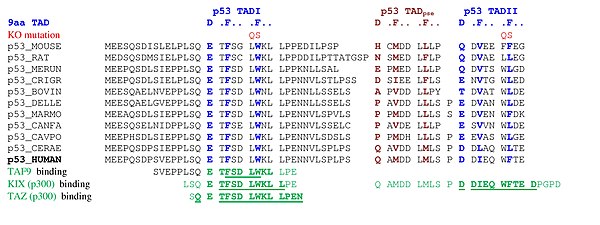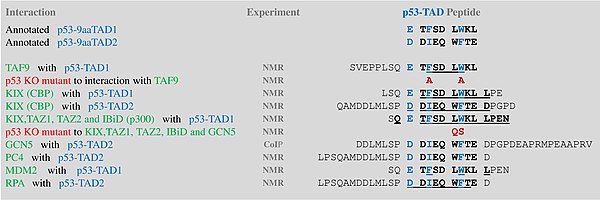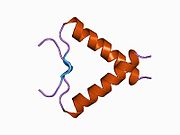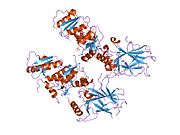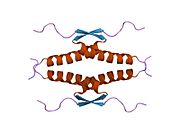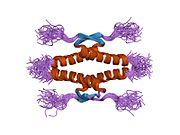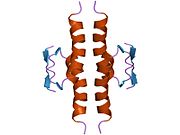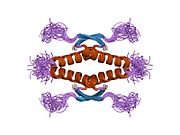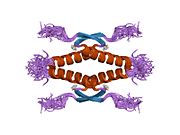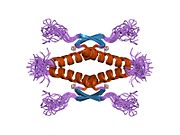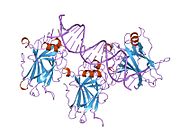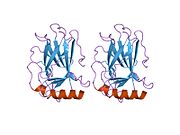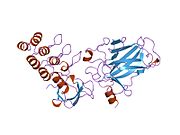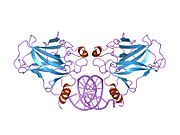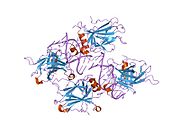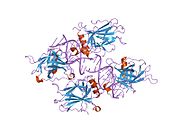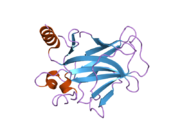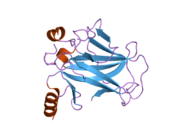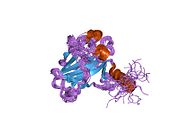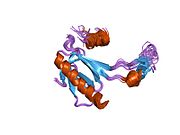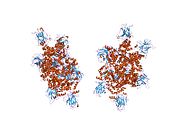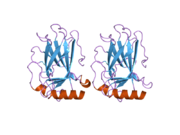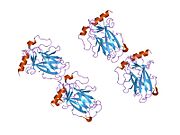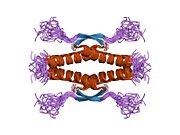P53: Difference between revisions
| Line 47: | Line 47: | ||
[[File:Piskacek p53a.jpg|600px]] |
[[File:Piskacek p53a.jpg|600px]] |
||
Mutations that deactivate p53 in cancer usually occur in the DBD. Most of these mutations destroy the ability of the protein to bind to its target DNA sequences, and thus prevents transcriptional activation of these genes. As such, mutations in the DBD are [[recessive allele|recessive]] [[loss-of-function]] mutations. Molecules of p53 with mutations in the OD dimerise with [[wild-type]] p53, and prevent them from activating transcription. Therefore OD mutations have a dominant negative effect on the function of p53. |
Mutations that deactivate p53 in cancer usually occur in the DBD. Most of these mutations destroy the ability of the protein to bind to its target DNA sequences, and thus prevents transcriptional activation of these genes. As such, mutations in the DBD are [[recessive allele|recessive]] [[loss-of-function]] mutations. Molecules of p53 with mutations in the OD dimerise with [[wild-type]] p53, and prevent them from activating transcription. Therefore OD mutations have a dominant negative effect on the function of p53. |
||
Wild-type p53 is a [[labile]] [[protein]], comprising folded and [[Intrinsically unstructured proteins|unstructured regions]] that function in a synergistic manner.<ref name="pmid12367518">{{vcite journal | author = Bell S, Klein C, Müller L, Hansen S, Buchner J | title = p53 contains large unstructured regions in its native state | journal = J. Mol. Biol. | volume = 322 | issue = 5 | pages = 917–27 | year = 2002 | pmid = 12367518 | doi = 10.1016/S0022-2836(02)00848-3 }}</ref> |
Wild-type p53 is a [[labile]] [[protein]], comprising folded and [[Intrinsically unstructured proteins|unstructured regions]] that function in a synergistic manner.<ref name="pmid12367518">{{vcite journal | author = Bell S, Klein C, Müller L, Hansen S, Buchner J | title = p53 contains large unstructured regions in its native state | journal = J. Mol. Biol. | volume = 322 | issue = 5 | pages = 917–27 | year = 2002 | pmid = 12367518 | doi = 10.1016/S0022-2836(02)00848-3 }}</ref> |
||
Revision as of 22:41, 5 December 2014
Tumor protein p53, also known as p53, cellular tumor antigen p53, phosphoprotein p53, or tumor suppressor p53, is a protein that in humans is encoded by the TP53 gene. The p53 protein is crucial in multicellular organisms, where it regulates the cell cycle and, thus, functions as a tumor suppressor, preventing cancer. As such, p53 has been described as "the guardian of the genome" because of its role in conserving stability by preventing genome mutation.[1] Hence TP53 is classified as a tumor suppressor gene.[2][3][4][5]
The name p53 is in reference to its apparent molecular mass: SDS-PAGE analysis indicates that it is a 53-kilodalton (kDa) protein. However, based on calculations from its amino acid residues, p53's mass is actually only 43.7 kDa. This difference is due to the high number of proline residues in the protein; these slow its migration on SDS-PAGE, thus making it appear heavier than it actually is.[6] This effect is observed with p53 from a variety of species, including humans, rodents, frogs, and fish.
p53 is also known as cellular tumor antigen p53 (UniProt name), antigen NY-CO-13, phosphoprotein p53, transformation-related protein 53 (TRP53) and tumour suppressor p53.
Gene
In humans, the TP53 gene is located on the short arm of chromosome 17 (17p13.1).[2][3][4][5] The gene spans 20 kb, with a non-coding exon 1 and a very long first intron of 10 kb. The coding sequence contains five regions showing a high degree of conservation in vertebrates, predominantly in exons 2, 5, 6, 7 and 8, but the sequences found in invertebrates show only distant resemblance to mammalian TP53.[7] TP53 orthologs[8] have been identified in most mammals for which complete genome data are available.
In humans, a common polymorphism involves the substitution of an arginine for a proline at codon position 72. Many studies have investigated a genetic link between this variation and cancer susceptibility; however, the results have been controversial. For instance, a meta-analysis from 2009 failed to show a link for cervical cancer.[9] A 2011 study found that the TP53 proline mutation did have a profound effect on pancreatic cancer risk among males.[10] A study of Arab women found that proline homozygosity at TP53 codon 72 is associated with a decreased risk for breast cancer.[11] One study suggested that TP53 codon 72 polymorphisms, MDM2 SNP309, and A2164G may collectively be associated with non-oropharyngeal cancer susceptibility and that MDM2 SNP309 in combination with TP53 codon 72 may accelerate the development of non-oropharyngeal cancer in women.[12] A 2011 study found that TP53 codon 72 polymorphism was associated with an increased risk of lung cancer.[13]
Meta-analyses from 2011 found no significant associations between TP53 codon 72 polymorphisms and both colorectal cancer risk[14] and endometrial cancer risk.[15] A 2011 study of a Brazilian birth cohort found an association between the non mutant arginine TP53 and individuals without a family history of cancer.[16] Another 2011 study found that the p53 homozygous (Pro/Pro) genotype was associated with a significantly increased risk for renal cell carcinoma.[17]
(Italics are used to denote the TP53 gene name and distinguish it from the protein it encodes.)
Structure


- an acidic N-terminus transcription-activation domain (TAD), also known as activation domain 1 (AD1), which activates transcription factors: residues 1-42. The N-terminus contains two complementary transcriptional activation domains, with a major one at residues 1–42 and a minor one at residues 55–75, specifically involved in the regulation of several pro-apoptotic genes.[18]
- activation domain 2 (AD2) important for apoptotic activity: residues 43-63.
- Proline rich domain important for the apoptotic activity of p53: residues 64-92.
- central DNA-binding core domain (DBD). Contains one zinc atom and several arginine amino acids: residues 102-292. This region is responsible for binding the p53 co-repressor LMO3.[19]
- nuclear localization signaling domain, residues 316-325.
- homo-oligomerisation domain (OD): residues 307-355. Tetramerization is essential for the activity of p53 in vivo.
- C-terminal involved in downregulation of DNA binding of the central domain: residues 356-393.[20]
A tandem of nine-amino-acid transactivation domains (9aaTAD) was identified in the AD1 and AD2 regions of transcription factor p53.[21] KO mutations and position for p53 interaction with TFIID are listed below:[22]
9aaTADs mediate p53 interaction with general coactivators - TAF9, CBP/p300 (all four domains KIX, TAZ1, TAZ2 and IBiD), GCN5 and PC4, regulatory protein MDM2 and replication protein A (RPA).[23][24]
Mutations that deactivate p53 in cancer usually occur in the DBD. Most of these mutations destroy the ability of the protein to bind to its target DNA sequences, and thus prevents transcriptional activation of these genes. As such, mutations in the DBD are recessive loss-of-function mutations. Molecules of p53 with mutations in the OD dimerise with wild-type p53, and prevent them from activating transcription. Therefore OD mutations have a dominant negative effect on the function of p53.
Wild-type p53 is a labile protein, comprising folded and unstructured regions that function in a synergistic manner.[25]
Function
p53 has many mechanisms of anticancer function, and plays a role in apoptosis, genomic stability, and inhibition of angiogenesis. In its anti-cancer role, p53 works through several mechanisms:
- It can activate DNA repair proteins when DNA has sustained damage. Thus, it may be an important factor in aging.[26]
- It can arrest growth by holding the cell cycle at the G1/S regulation point on DNA damage recognition (if it holds the cell here for long enough, the DNA repair proteins will have time to fix the damage and the cell will be allowed to continue the cell cycle).
- It can initiate apoptosis - programmed cell death - if DNA damage proves to be irreparable.
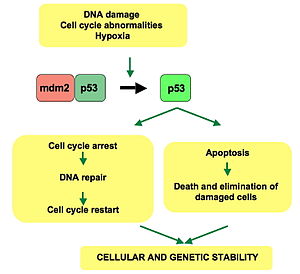
Activated p53 binds DNA and activates expression of several genes including microRNA miR-34a,[27] WAF1/CIP1 encoding for p21 and hundreds of other down-stream genes. p21 (WAF1) binds to the G1-S/CDK (CDK4/CDK6, CDK2, and CDK1) complexes (molecules important for the G1/S transition in the cell cycle) inhibiting their activity.
When p21(WAF1) is complexed with CDK2 the cell cannot continue to the next stage of cell division. A mutant p53 will no longer bind DNA in an effective way, and, as a consequence, the p21 protein will not be available to act as the "stop signal" for cell division.[28] Studies of human embryonic stem cells (hESCs) commonly describe the nonfunctional p53-p21 axis of the G1/S checkpoint pathway with subsequent relevance for cell cycle regulation and the DNA damage response (DDR). Importantly, p21 mRNA is clearly present and upregulated after the DDR in hESCs, but p21 protein is not detectable. In this cell type, p53 activates numerous microRNAs (like miR-302a, miR-302b, miR-302c, and miR-302d) that directly inhibit the p21 expression in hESCs.[29]
Recent research has also linked the p53 and RB1 pathways, via p14ARF, raising the possibility that the pathways may regulate each other.[30]
p53 by regulating LIF has been shown to facilitate implantation in the mouse model and possibly in humans.[31]
p53 expression can be stimulated by UV light, which also causes DNA damage. In this case, p53 can initiate events leading to tanning.[32][33]
Regulation
p53 becomes activated in response to myriad stressors, including but not limited to DNA damage (induced by either UV, IR, or chemical agents such as hydrogen peroxide), oxidative stress,[34] osmotic shock, ribonucleotide depletion, and deregulated oncogene expression. This activation is marked by two major events. First, the half-life of the p53 protein is increased drastically, leading to a quick accumulation of p53 in stressed cells. Second, a conformational change forces p53 to be activated as a transcription regulator in these cells. The critical event leading to the activation of p53 is the phosphorylation of its N-terminal domain. The N-terminal transcriptional activation domain contains a large number of phosphorylation sites and can be considered as the primary target for protein kinases transducing stress signals.
The protein kinases that are known to target this transcriptional activation domain of p53 can be roughly divided into two groups. A first group of protein kinases belongs to the MAPK family (JNK1-3, ERK1-2, p38 MAPK), which is known to respond to several types of stress, such as membrane damage, oxidative stress, osmotic shock, heat shock, etc. A second group of protein kinases (ATR, ATM, CHK1 and CHK2, DNA-PK, CAK, TP53RK) is implicated in the genome integrity checkpoint, a molecular cascade that detects and responds to several forms of DNA damage caused by genotoxic stress. Oncogenes also stimulate p53 activation, mediated by the protein p14ARF.
In unstressed cells, p53 levels are kept low through a continuous degradation of p53. A protein called Mdm2 (also called HDM2 in humans), which is itself a product of p53, binds to p53, preventing its action and transports it from the nucleus to the cytosol. Also Mdm2 acts as ubiquitin ligase and covalently attaches ubiquitin to p53 and thus marks p53 for degradation by the proteasome. However, ubiquitylation of p53 is reversible.
A ubiquitin specific protease, USP7 (or HAUSP), can cleave ubiquitin off p53, thereby protecting it from proteasome-dependent degradation. This is one means by which p53 is stabilized in response to oncogenic insults. USP42 has also been shown to deubiquitinate p53 and may be required for the ability of p53 to respond to stress.[35]
Recent research has shown that HAUSP is mainly localized in the nucleus, though a fraction of it can be found in the cytoplasm and mitochondria. Overexpression of HAUSP results in p53 stabilization. However, depletion of HAUSP does not result to a decrease in p53 levels but rather increases p53 levels due to the fact that HAUSP binds and deubiquitinates Mdm2. It has been shown that HAUSP is a better binding partner to Mdm2 than p53 in unstressed cells.
USP10 however has been shown to be located in the cytoplasm in unstressed cells and deubiquitinates cyptoplasmic p53, reversing Mdm2 ubiquitination. Following DNA damage, USP10 translocates to the nucleus and contributes to p53 stability. Also USP10 does not interact with Mdm2.[36]
Phosphorylation of the N-terminal end of p53 by the above-mentioned protein kinases disrupts Mdm2-binding. Other proteins, such as Pin1, are then recruited to p53 and induce a conformational change in p53, which prevents Mdm2-binding even more. Phosphorylation also allows for binding of transcriptional coactivators, like p300 and PCAF, which then acetylate the carboxy-terminal end of p53, exposing the DNA binding domain of p53, allowing it to activate or repress specific genes. Deacetylase enzymes, such as Sirt1 and Sirt7, can deacetylate p53, leading to an inhibition of apoptosis.[37] Some oncogenes can also stimulate the transcription of proteins that bind to MDM2 and inhibit its activity.
Role in disease

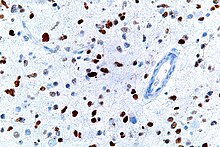
If the TP53 gene is damaged, tumor suppression is severely compromised. People who inherit only one functional copy of the TP53 gene will most likely develop tumors in early adulthood, a disorder known as Li-Fraumeni syndrome. The TP53 gene can also be modified by mutagens (chemicals, radiation, or viruses), increasing the likelihood for uncontrolled cell division. More than 50 percent of human tumors contain a mutation or deletion of the TP53 gene.[38] Increasing the amount of p53 may seem a solution for treatment of tumors or prevention of their spreading. This, however, is not a usable method of treatment, since it can cause premature aging.[39] Restoring endogenous normal p53 function holds some promise. Research has showed that this restoration can lead to regression of certain cancer cells without damaging other cells in the process. The ways by which tumor regression occurs depends mainly on the tumor type. For example, restoration of endogenous p53 function in lymphomas may induce apoptosis, while cell growth may be reduced to normal levels. Thus, pharmacological reactivation of p53 presents itself as a viable cancer treatment option.[40][41][42] Loss of p53 creates genomic instability that most often results in an aneuploidy phenotype.[43]
Certain pathogens can also affect the p53 protein that the TP53 gene expresses. One such example, human papillomavirus (HPV), encodes a protein, E6, which binds to the p53 protein and inactivates it. This mechanism, in synergy with the inactivation of the cell cycle regulator pRb, by the HPV protein E7, allows for repeated cell division manifested clinically as warts. Certain HPV types, in particular types 16 and 18, can also lead to progression from a benign wart to low or high-grade cervical dysplasia, which are reversible forms of precancerous lesions. Persistent infection of the cervix over the years can cause irreversible changes leading to carcinoma in situ and eventually invasive cervical cancer. This results from the effects of HPV genes, particularly those encoding E6 and E7, which are the two viral oncoproteins that are preferentially retained and expressed in cervical cancers by integration of the viral DNA into the host genome.[44]
The p53 protein is continually produced and degraded in cells of healthy people. The degradation of the p53 protein is associated with binding of MDM2. In a negative feedback loop, MDM2 itself is induced by the p53 protein. Mutant p53 proteins often fail to induce MDM2, causing p53 to accumulate at very high levels. Moreover, the mutant p53 protein itself can inhibit normal p53 protein levels. In some cases, single missense mutations in p53 have been shown to disrupt p53 stability and function.[45]
Experimental analysis of p53 mutations
Most p53 mutations are detected by DNA sequencing. However, it is known that single missense mutations can have a large spectrum from rather mild to very severe functional effects.[45]
Discovery
p53 was identified in 1979 by Lionel Crawford, David P. Lane, Arnold Levine, and Lloyd Old, working at Imperial Cancer Research Fund (UK) Princeton University/UMDNJ (Cancer Institute of New Jersey), and Memorial Sloan-Kettering Cancer Center, respectively. It had been hypothesized to exist before as the target of the SV40 virus, a strain that induced development of tumors. The TP53 gene from the mouse was first cloned by Peter Chumakov of the Russian Academy of Sciences in 1982,[46] and independently in 1983 by Moshe Oren in collaboration with David Givol (Weizmann Institute of Science).[47][48] The human TP53 gene was cloned in 1984[2] and the full length clone in 1985.[49]
It was initially presumed to be an oncogene due to the use of mutated cDNA following purification of tumour cell mRNA. Its character as a tumor suppressor gene was finally revealed in 1989 by Bert Vogelstein working at Johns Hopkins School of Medicine.[50]
Warren Maltzman, of the Waksman Institute of Rutgers University first demonstrated that TP53 was responsive to DNA damage in the form of ultraviolet radiation.[51] In a series of publications in 1991-92, Michael Kastan, Johns Hopkins University, reported that TP53 was a critical part of a signal transduction pathway that helped cells respond to DNA damage.[52]
In 1993, p53 was voted molecule of the year by Science magazine.[53]
The p21 protein binds directly to cyclin-CDK complexes that drive forward the cell cycle and inhibits their kinase activity thereby causing cell cycle arrest to allow repair to take place. p21 can also mediate growth arrest associated with differentiation and a more permanent growth arrest associated with cellular senescence. The p21 gene contains several p53 response elements that mediate direct binding of the p53 protein, resulting in transcriptional activation of the gene encoding the p21 protein.
Interactions
p53 has been shown to interact with:
- AIMP2,[54]
- ANKRD2,[55]
- APTX,[56]
- ATM,[57][58][59][60][61]
- ATR,[57][58]
- ATF3,[62][63]
- AURKA,[64]
- BAK1,[65]
- BARD1,[66]
- BLM,[67][68][69][70]
- BRCA1,[66][71][72][73][74]
- BRCA2,[66][75]
- BRCC3,[66]
- BRE,[66]
- CEBPZ,[76]
- CDC14A,[77]
- Cdk1,[78][79]
- CFLAR,[80]
- CHEK1,[67][81][82]
- CCNG1,[83]
- CREBBP,[84][85][86]
- CREB1,[86]
- Cyclin H,[87]
- CDK7,[87][88]
- DNA-PKcs,[58][81][89]
- E4F1,[90][91]
- EFEMP2,[92]
- EIF2AK2,[93]
- ELL,[94]
- EP300,[85][95][96][97]
- ERCC6,[98][99]
- GNL3,[100]
- GPS2,[101]
- GSK3B,[102]
- HSP90AA1,[103][104][105]
- HIF1A,[106][107][108][109]
- HIPK1,[110]
- HIPK2,[111][112]
- HMGB1,[113][114]
- HSPA9,[115]
- Huntingtin,[116]
- ING1,[117][118]
- ING4,[119][120]
- ING5,[119]
- IκBα,[121]
- KPNB1,[103]
- LMO3,[19]
- Mdm2,[84][122][123][124]
- MDM4,[125][126]
- MED1,[127][128]
- MAPK9,[129][130]
- MNAT1,[88]
- NDN,[131]
- NCL,[132]
- NUMB,[133]
- NF-κB,[134]
- P16,[90][124][135]
- PARC,[136]
- PARP1,[56][137]
- PIAS1,[92][138]
- CDC14B,[77]
- PIN1,[139][140]
- PLAGL1,[141]
- PLK3,[142][143]
- PRKRA,[144]
- PHB,[145]
- PML,[122][146][147]
- PSME3,[148]
- PTEN,[123]
- PTK2,[149]
- PTTG1,[150]
- RAD51,[66][151][152]
- RCHY1,[153][154]
- RELA,[134]
- Reprimo
- RPA1,[155][156]
- RPL11,[135]
- S100B,[157]
- SUMO1,[158][159]
- SMARCA4,[160]
- SMARCB1,[160]
- SMN1,[161]
- STAT3,[134]
- TBP,[162][163]
- TFAP2A,[164]
- TFDP1,[165]
- TIGAR,[166]
- TOP1,[167][168]
- TOP2A,[169]
- TP53BP1,[67][170][171][172][173][174][175]
- TP53BP2,[175][176]
- TOP2B,[169]
- TP53INP1,[177][178]
- TSG101,[179]
- UBE2A,[180]
- UBE2I,[92][158][181][182]
- UBC,[54][148][159][183][184][185][186][187]
- USP7,[188]
- WRN,[70][189]
- WWOX,[190]
- XPB,[98]
- YBX1,[55][191]
- YPEL3,[192]
- YWHAZ,[193]
- Zif268,[194]
- ZNF148,[195]
Interactive pathway map
Click on genes, proteins and metabolites below to link to respective articles.[§ 1]
- ^ The interactive pathway map can be edited at WikiPathways: "FluoropyrimidineActivity_WP1601".
References
- ^ Read, A. P.; Strachan, T.. Human molecular genetics 2. New York: Wiley; 1999. ISBN 0-471-33061-2. Chapter 18: Cancer Genetics.
- ^ a b c Matlashewski G, Lamb P, Pim D, Peacock J, Crawford L, Benchimol S. Isolation and characterization of a human p53 cDNA clone: expression of the human p53 gene. EMBO J.. 1984;3(13):3257–62. PMID 6396087.
- ^ a b Isobe M, Emanuel BS, Givol D, Oren M, Croce CM. Localization of gene for human p53 tumour antigen to band 17p13. Nature. 1986;320(6057):84–5. doi:10.1038/320084a0. PMID 3456488.
- ^ a b Kern SE, Kinzler KW, Bruskin A, Jarosz D, Friedman P, Prives C, Vogelstein B. Identification of p53 as a sequence-specific DNA-binding protein. Science. 1991;252(5013):1708–11. doi:10.1126/science.2047879. PMID 2047879.
- ^ a b McBride OW, Merry D, Givol D. The gene for human p53 cellular tumor antigen is located on chromosome 17 short arm (17p13). Proc. Natl. Acad. Sci. U.S.A.. 1986;83(1):130–134. doi:10.1073/pnas.83.1.130. PMID 3001719.
- ^ Ziemer MA, Mason A, Carlson DM. Cell-free translations of proline-rich protein mRNAs. J. Biol. Chem.. 1982;257(18):11176–80. PMID 7107651.
- ^ May P, May E. Twenty years of p53 research: structural and functional aspects of the p53 protein. Oncogene. 1999;18(53):7621–36. doi:10.1038/sj.onc.1203285. PMID 10618702.
- ^ OrthoMaM phylogenetic marker: TP53 coding sequence.
- ^ Klug SJ, Ressing M, Koenig J, Abba MC, Agoras\ VM, Sengupta S, Settheetham-Ishida W, Shirasawa H, Snijders PJ, Stoler MH, Suárez-Rincón AE, Szarka K, Tachezy R, Ueda M, van der Zee AG, von Knebel Doeberitz M, Wu MT, Yamashita T, Zehbe I, Blettner M. TP53 codon 72 polymorphism and cervical cancer: a pooled analysis of individual data from 49 studies. Lancet Oncology. 2009;10(2):772–784. doi:10.1016/S1470-2045(09)70187-1. PMID 19625214.
- ^ Sonoyama T, Sakai A, Mita Y, Yasuda Y, Kawamoto H, Yagi T, Yoshioka M, Mimura T, Nakachi K, Ouchida M, Yamamoto K, Shimizu K. TP53 codon 72 polymorphism is associated with pancreatic cancer risk in males, smokers and drinkers. Mol Med Report. 2011;4(3):489–95. doi:10.3892/mmr.2011.449. PMID 21468597.
- ^ Alawadi S, Ghabreau L, Alsaleh M, Abdulaziz Z, Rafeek M, Akil N, Alkhalaf M. P53 gene polymorphisms and breast cancer risk in Arab women. Med. Oncol.. 2011;28(3):709–15. doi:10.1007/s12032-010-9505-4. PMID 20443084.
- ^ Yu H, Huang YJ, Liu Z, Wang LE, Li G, Sturgis EM, Johnson DG, Wei Q. Effects of MDM2 promoter polymorphisms and p53 codon 72 polymorphism on risk and age at onset of squamous cell carcinoma of the head and neck. Mol. Carcinog.. 2011;50(9):697–706. doi:10.1002/mc.20806. PMID 21656578.
- ^ Piao JM, Kim HN, Song HR, Kweon SS, Choi JS, Yun WJ, Kim YC, Oh IJ, Kim KS, Shin MH. p53 codon 72 polymorphism and the risk of lung cancer in a Korean population. Lung Cancer. 2011;73(3):264–7. doi:10.1016/j.lungcan.2010.12.017. PMID 21316118.
- ^ Wang JJ, Zheng Y, Sun L, Wang L, Yu PB, Dong JH, Zhang L, Xu J, Shi W, Ren YC. TP53 codon 72 polymorphism and colorectal cancer susceptibility: a meta-analysis. Mol. Biol. Rep.. 2011;38(8):4847–53. doi:10.1007/s11033-010-0619-8. PMID 21140221.
- ^ Jiang DK, Yao L, Ren WH, Wang WZ, Peng B, Yu L. TP53 Arg72Pro polymorphism and endometrial cancer risk: a meta-analysis. Med. Oncol.. 2011;28(4):1129–35. doi:10.1007/s12032-010-9597-x. PMID 20552298.
- ^ Thurow HS, Haack R, Hartwig FP, Oliveira IO, Dellagostin OA, Gigante DP, Horta BL, Collares T, Seixas FK. TP53 gene polymorphism: importance to cancer, ethnicity and birth weight in a Brazilian cohort. J. Biosci.. 2011;36(5):823–31. doi:10.1007/s12038-011-9147-5. PMID 22116280.
- ^ Huang CY, Su CT, Chu JS, Huang SP, Pu YS, Yang HY, Chung CJ, Wu CC, Hsueh YM. The polymorphisms of P53 codon 72 and MDM2 SNP309 and renal cell carcinoma risk in a low arsenic exposure area. Toxicol. Appl. Pharmacol.. 2011;257(3):349–55. doi:10.1016/j.taap.2011.09.018. PMID 21982800.
- ^ Venot C, Maratrat M, Dureuil C, Conseiller E, Bracco L, Debussche L. The requirement for the p53 proline-rich functional domain for mediation of apoptosis is correlated with specific PIG3 gene transactivation and with transcriptional repression. EMBO J.. 1998;17(16):4668–79. doi:10.1093/emboj/17.16.4668. PMID 9707426.
- ^ a b Larsen S, Yokochi T, Isogai E, Nakamura Y, Ozaki T, Nakagawara A. LMO3 interacts with p53 and inhibits its transcriptional activity. Biochem. Biophys. Res. Commun.. 2010;392(3):252–7. doi:10.1016/j.bbrc.2009.12.010. PMID 19995558.
- ^ Harms KL, Chen X. The C Terminus of p53 Family Proteins Is a Cell Fate Determinant. Mol. Cell. Biol.. 2005;25(5):2014–30. doi:10.1128/MCB.25.5.2014-2030.2005. PMID 15713654.
- ^ Piskacek S, Gregor M, Nemethova M, Grabner M, Kovarik P, Piskacek M. Nine-amino-acid transactivation domain: establishment and prediction utilities. Genomics. 2007;89(6):756–68. doi:10.1016/j.ygeno.2007.02.003. PMID 17467953.
- ^ Uesugi M, Nyanguile O, Lu H, Levine AJ, Verdine GL. Induced alpha helix in the VP16 activation domain upon binding to a human TAFf. Science. 1997;277(5330):1310–3. doi:10.1126/science.277.5330.1310. PMID 9271577.; Uesugi M, Verdine GL. The α-helical FXXΦΦ motif in p53: TAF interaction and discrimination by MDM2. Proc. Natl. Acad. Sci. U.S.A.. 1999;96(26):14801–6. doi:10.1073/pnas.96.26.14801. PMID 10611293.; Choi Y, Asada S, Uesugi M. Divergent hTAFII31-binding motifs hidden in activation domains. J. Biol. Chem.. 2000;275(21):15912–6. doi:10.1074/jbc.275.21.15912. PMID 10821850.; Venot C, Maratrat M, Sierra V, Conseiller E, Debussche L. Definition of a p53 transactivation function-deficient mutant and characterization of two independent p53 transactivation subdomains. Oncogene. 1999;18(14):2405–10. doi:10.1038/sj.onc.1202539. PMID 10327062.; Lin J, Chen J, Elenbaas B, Levine AJ. Several hydrophobic amino acids in the p53 amino-terminal domain are required for transcriptional activation, binding to mdm-2 and the adenovirus 5 E1B 55-kD protein. Genes Dev.. 1994;8(10):1235–46. doi:10.1101/gad.8.10.1235. PMID 7926727.
- ^ Piskacek S, Gregor M, Nemethova M, Grabner M, Kovarik P, Piskacek M. Nine-amino-acid transactivation domain: establishment and prediction utilities. Genomics. 2007;89(6):756–68. doi:10.1016/j.ygeno.2007.02.003. PMID 17467953.; Piskacek M. 9aaTAD is a common transactivation domain recruits multiple general coactivators TAF9, MED15, CBP/p300 and GCN5. Nature Precedings Pre-publication. 2009. doi:10.1038/npre.2009.3488.2.; Piskacek M. 9aaTADs mimic DNA to interact with a pseudo-DNA Binding Domain KIX of Med15 (Molecular Chameleons). Nature Precedings Pre-publication. 2009. doi:10.1038/npre.2009.3939.1.; Piskacek M. 9aaTAD Prediction result (2006). Nature Precedings Pre-publication. 2009. doi:10.1038/npre.2009.3984.1.
- ^ The prediction for 9aaTADs (for both acidic and hydrophilic transactivation domains) is available online from ExPASy http://us.expasy.org/tools/ and EMBnet Spain http://www.es.embnet.org/Services/EMBnetAT/htdoc/9aatad/
- ^ Bell S, Klein C, Müller L, Hansen S, Buchner J. p53 contains large unstructured regions in its native state. J. Mol. Biol.. 2002;322(5):917–27. doi:10.1016/S0022-2836(02)00848-3. PMID 12367518.
- ^ Gilbert, Scott F. Developmental Biology, 10th ed. Sunderland, MA USA: Sinauer Associates, Inc. Publishers. pp. p.588.
{{cite book}}:|pages=has extra text (help) - ^ Mraz M, Malinova K, Kotaskova J, Pavlova S, Tichy B, Malcikova J, Stano Kozubik K, Smardova J, Brychtova Y. MiR-34a, miR-29c and miR-17-5p are downregulated in CLL patients with TP53 abnormalities. Leukemia : official journal of the Leukemia Society of America, Leukemia Research Fund, U.K. 2009;23(6):1159–63. doi:10.1038/leu.2008.377. PMID 19158830.
- ^ National Center for Biotechnology Information. United States National Institutes of Health. The p53 tumor suppressor protein [Retrieved 2008-05-28].
- ^ Dolezalova D, Mraz M, Barta T, Plevova K, Vinarsky V, Holubcova Z, Jaros J, Dvorak P, Pospisilova S, Hampl A.. MicroRNAs regulate p21(Waf1/Cip1) protein expression and the DNA damage response in human embryonic stem cells.. Stem Cells. 2012;7:1362-72.. doi:10.1002/stem.1108.. PMID 22511267.
- ^ Bates S, Phillips AC, Clark PA, Stott F, Peters G, Ludwig RL, Vousden KH. p14ARF links the tumour suppressors RB and p53. Nature. 1998;395(6698):124–5. doi:10.1038/25867. PMID 9744267.
- ^ Hu W, Feng Z, Teresky AK, Levine AJ. p53 regulates maternal reproduction through LIF. Nature. 2007;450(7170):721–4. doi:10.1038/nature05993. PMID 18046411.
- ^ Genome's guardian gets a tan started. March 17, 2007 [Retrieved 2007-03-29]. New Scientist.
- ^ Cui R, Widlund HR, Feige E, Lin JY, Wilensky DL, Igras VE, D'Orazio J, Fung CY, Schanbacher CF, Granter SR, Fisher DE. Central role of p53 in the suntan response and pathologic hyperpigmentation. Cell. 2007;128(5):853–64. doi:10.1016/j.cell.2006.12.045. PMID 17350573.
- ^ Han ES, Muller FL, Pérez VI, Qi W, Liang H, Xi L, Fu C, Doyle E, Hickey M, Cornell J, Epstein CJ, Roberts LJ, Van Remmen H, Richardson A. The in vivo Gene Expression Signature of Oxidative Stress. Physiol. Genomics. 2008;34(1):112–26. doi:10.1152/physiolgenomics.00239.2007. PMID 18445702.
- ^ Hock AK, Vigneron AM, Carter S, Ludwig RL, Vousden KH (2011). "Regulation of p53 stability and function by the deubiquitinating enzyme USP42". EMBO J. 30 (24): 4921–30. doi:10.1038/emboj.2011.419.
{{cite journal}}: CS1 maint: multiple names: authors list (link) - ^ Yuan; et al. (5 February 2011). "USP10 regulates p53 localization and Stability by Deubiquitinating p53".
{{cite journal}}: Cite journal requires|journal=(help); Explicit use of et al. in:|last=(help) - ^ Vakhrusheva O, Smolka C, Gajawada P, Kostin S, Boettger T, Kubin T, Braun T, Bober. Sirt7 increases stress resistance of cardiomyocytes and prevents apoptosis and inflammatory cardiomyopathy in mice. Circ. Res.. 2008;102(6):703–10. doi:10.1161/CIRCRESAHA.107.164558. PMID 18239138.
- ^ Hollstein M, Sidransky D, Vogelstein B, Harris CC. p53 mutations in human cancers. Science. 1991;253(5015):49–53. doi:10.1126/science.1905840. PMID 1905840.
- ^ Tyner SD, Venkatachalam S, Choi J, Jones S, Ghebranious N, Igelmann H, Lu X, Soron G, Cooper B, Brayton C, Hee Park S, Thompson T, Karsenty G, Bradley A, Donehower LA. p53 mutant mice that display early ageing-associated phenotypes. Nature. 2002;415(6867):45–53. doi:10.1038/415045a. PMID 11780111.
- ^ Ventura, Andrea; David Kirsch; Margaret McLaughlin; David A. Tuveson; Jan Grimm; Laura Lintault; Jamie Newman; Elizabeth E. Reczek; Ralph Weissleder; Tyler Jacks (8 February 2007). "Restoration of p53 function leads to tumour regression in vivo". International weekly journal of science. 445 (7128): 661–665. doi:10.1038/nature05541. PMID 17251932. Retrieved 2013-03-29.
- ^ Ventura A, Kirsch DG, McLaughlin ME, Tuveson DA, Grimm J, Lintault L, Newman J, Reczek EE, Weissleder R, Jacks T. Restoration of p53 function leads to tumour regression in vivo. Nature. 2007;445(7128):661–5. doi:10.1038/nature05541. PMID 17251932.
- ^ Herce, HD; Deng, W; Helma, J; Leonhardt, H; Cardoso, MC (2013). "Visualization and targeted disruption of protein interactions in living cells". Nature communications. 4: 2660. doi:10.1038/ncomms3660. PMID 24154492.
- ^ Schmitt CA, Fridman JS, Yang M, Baranov E, Hoffman RM, Lowe SW. Dissecting p53 tumor suppressor functions in vivo. Cancer Cell. 2002;1(3):289–298. doi:10.1016/S1535-6108(02)00047-8. PMID 12086865.
- ^ Angeletti PC, Zhang L, Wood C. The Viral Etiology of AIDS-Associated Malignancies. Adv. Pharmacol.. 2008;56:509–57. doi:10.1016/S1054-3589(07)56016-3. PMID 18086422.
- ^ a b Bullock AN, Henckel J, DeDecker BS, Johnson CM, Nikolova PV, Proctor MR, Lane DP, Fersht AR. Thermodynamic stability of wild-type and mutant p53 core domain. Proc. Natl. Acad. Sci. U.S.A.. 1997;94(26):14338–42. doi:10.1073/pnas.94.26.14338. PMID 9405613.
- ^ Chumakov PM, Iotsova VS, Georgiev GP. [Isolation of a plasmid clone containing the mRNA sequence for mouse nonviral T-antigen]. Dokl. Akad. Nauk SSSR. 1982;267(5):1272–5. Russian. PMID 6295732.
- ^ Oren M, Levine AJ. Molecular cloning of a cDNA specific for the murine p53 cellular tumor antigen. Proc. Natl. Acad. Sci. U.S.A.. 1983;80(1):56–9. doi:10.1073/pnas.80.1.56. PMID 6296874.
- ^ Zakut-Houri R, Oren M, Bienz B, Lavie V, Hazum S, Givol D. A single gene and a pseudogene for the cellular tumour antigen p53. Nature. 1983;306(5943):594–7. doi:10.1038/306594a0. PMID 6646235.
- ^ Zakut-Houri R, Bienz-Tadmor B, Givol D, Oren M. Human p53 cellular tumor antigen: cDNA sequence and expression in COS cells. EMBO J.. 1985;4(5):1251–5. PMID 4006916.
- ^ Baker SJ, Fearon ER, Nigro JM, Hamilton SR, Preisinger AC, Jessup JM, vanTuinen P, Ledbetter DH, Barker DF, Nakamura Y, White R, Vogelstein B. Chromosome 17 deletions and p53 gene mutations in colorectal carcinomas. Science. 1989;244(4901):217–21. doi:10.1126/science.2649981. PMID 2649981.
- ^ Maltzman W, Czyzyk L. UV irradiation stimulates levels of p53 cellular tumor antigen in nontransformed mouse cells. Mol. Cell. Biol.. 1984;4(9):1689–94. PMID 6092932.
- ^ Kastan MB, Kuerbitz SJ. Control of G1 arrest after DNA damage. Environ. Health Perspect.. 1993;101 Suppl 5(Suppl 5):55–8. doi:10.2307/3431842. PMID 8013425.
- ^ Koshland DE. Molecule of the year. Science. 1993;262(5142):1953. doi:10.1126/science.8266084. PMID 8266084.
- ^ a b Han JM, Park Bum-Joon, Park Sang Gyu, Oh Young Sun, Choi So Jung, Lee Sang Won, Hwang Soon-Kyung, Chang Seung-Hee, Cho Myung-Haing, Kim Sunghoon. AIMP2/p38, the scaffold for the multi-tRNA synthetase complex, responds to genotoxic stresses via p53. Proc. Natl. Acad. Sci. U.S.A.. 2008;105(32):11206–11. doi:10.1073/pnas.0800297105. PMID 18695251.
- ^ a b Kojic S, Medeot Elisa, Guccione Ernesto, Krmac Helena, Zara Ivano, Martinelli Valentina, Valle Giorgio, Faulkner Georgine. The Ankrd2 protein, a link between the sarcomere and the nucleus in skeletal muscle. J. Mol. Biol.. 2004;339(2):313–25. doi:10.1016/j.jmb.2004.03.071. PMID 15136035.
- ^ a b Gueven N, Becherel Olivier J, Kijas Amanda W, Chen Philip, Howe Orla, Rudolph Jeanette H, Gatti Richard, Date Hidetoshi, Onodera Osamu, Taucher-Scholz Gisela, Lavin Martin F. Aprataxin, a novel protein that protects against genotoxic stress. Hum. Mol. Genet.. 2004;13(10):1081–93. doi:10.1093/hmg/ddh122. PMID 15044383.
- ^ a b Fabbro M., Savage Kienan, Hobson Karen, Deans Andrew J, Powell SN, McArthur Grant A, Khanna Kum Kum. BRCA1-BARD1 complexes are required for p53Ser-15 phosphorylation and a G1/S arrest following ionizing radiation-induced DNA damage. J. Biol. Chem.. 2004;279(30):31251–8. doi:10.1074/jbc.M405372200. PMID 15159397.
- ^ a b c Kim ST, Lim D S, Canman C E, Kastan M B. Substrate specificities and identification of putative substrates of ATM kinase family members. J. Biol. Chem.. 1999;274(53):37538–43. doi:10.1074/jbc.274.53.37538. PMID 10608806.
- ^ Kang J, Ferguson David, Song Hoseok, Bassing Craig, Eckersdorff Mark, Alt Frederick W, Xu Yang. Functional Interaction of H2AX, NBS1, and p53 in ATM-Dependent DNA Damage Responses and Tumor Suppression. Mol. Cell. Biol.. 2005;25(2):661–70. doi:10.1128/MCB.25.2.661-670.2005. PMID 15632067.
- ^ Khanna KK, Keating K E, Kozlov S, Scott S, Gatei M, Hobson K, Taya Y, Gabrielli B, Chan D, Lees-Miller S P, Lavin M F. ATM associates with and phosphorylates p53: mapping the region of interaction. Nat. Genet.. 1998;20(4):398–400. doi:10.1038/3882. PMID 9843217.
- ^ Westphal CH, Schmaltz C, Rowan S, Elson A, Fisher D E, Leder P. Genetic interactions between atm and p53 influence cellular proliferation and irradiation-induced cell cycle checkpoints. Cancer Res.. 1997;57(9):1664–7. PMID 9135004.
- ^ Stelzl U, Worm U, Lalowski M, Haenig C, Brembeck FH, Goehler H, Stroedicke M, Zenkner M, Schoenherr A, Koeppen S, Timm J, Mintzlaff S, Abraham C, Bock N, Kietzmann S, Goedde A, Toksöz E, Droege A, Krobitsch S, Korn B, Birchmeier W, Lehrach H, Wanker EE (September 2005). "A human protein-protein interaction network: a resource for annotating the proteome". Cell. 122 (6): 957–68. doi:10.1016/j.cell.2005.08.029. PMID 16169070.
{{cite journal}}: CS1 maint: multiple names: authors list (link) - ^ Yan C, Wang Heng, Boyd Douglas D. ATF3 represses 72-kDa type IV collagenase (MMP-2) expression by antagonizing p53-dependent trans-activation of the collagenase promoter. J. Biol. Chem.. 2002;277(13):10804–12. doi:10.1074/jbc.M112069200. PMID 11792711.
- ^ Chen S-S, Chang Pi-Chu, Cheng Yu-Wen, Tang Fen-Mei, Lin Young-Sun. Suppression of the STK15 oncogenic activity requires a transactivation-independent p53 function. EMBO J.. 2002;21(17):4491–9. doi:10.1093/emboj/cdf409. PMID 12198151.
- ^ Leu JI-J, Dumont Patrick, Hafey Michael, Murphy Maureen E, George Donna L. Mitochondrial p53 activates Bak and causes disruption of a Bak-Mcl1 complex. Nat. Cell Biol.. 2004;6(5):443–50. doi:10.1038/ncb1123. PMID 15077116.
- ^ a b c d e f Dong Y, Hakimi Mohamed-Ali, Chen Xiaowei, Kumaraswamy Easwari, Cooch Neil S, Godwin Andrew K, Shiekhattar Ramin. Regulation of BRCC, a holoenzyme complex containing BRCA1 and BRCA2, by a signalosome-like subunit and its role in DNA repair. Mol. Cell. 2003;12(5):1087–99. doi:10.1016/S1097-2765(03)00424-6. PMID 14636569.
- ^ a b c Sengupta S, Robles Ana I, Linke Steven P, Sinogeeva Natasha I, Zhang Ran, Pedeux Remy, Ward Irene M, Celeste Arkady, Nussenzweig André, Chen Junjie, Halazonetis Thanos D, Harris Curtis C. Functional interaction between BLM helicase and 53BP1 in a Chk1-mediated pathway during S-phase arrest. J. Cell Biol.. 2004;166(6):801–13. doi:10.1083/jcb.200405128. PMID 15364958.
- ^ Wang XW, Tseng A, Ellis N A, Spillare E A, Linke S P, Robles A I, Seker H, Yang Q, Hu P, Beresten S, Bemmels N A, Garfield S, Harris C C. Functional interaction of p53 and BLM DNA helicase in apoptosis. J. Biol. Chem.. 2001;276(35):32948–55. doi:10.1074/jbc.M103298200. PMID 11399766.
- ^ Garkavtsev IV, Kley N, Grigorian I A, Gudkov A V. The Bloom syndrome protein interacts and cooperates with p53 in regulation of transcription and cell growth control. Oncogene. 2001;20(57):8276–80. doi:10.1038/sj.onc.1205120. PMID 11781842.
- ^ a b Yang Q, Zhang Ran, Wang Xin Wei, Spillare Elisa A, Linke Steven P, Subramanian Deepa, Griffith Jack D, Li Ji Liang, Hickson Ian D, Shen Jiang Cheng, Loeb Lawrence A, Mazur Sharlyn J, Appella Ettore, Brosh Robert M, Karmakar Parimal, Bohr Vilhelm A, Harris Curtis C. The processing of Holliday junctions by BLM and WRN helicases is regulated by p53. J. Biol. Chem.. 2002;277(35):31980–7. doi:10.1074/jbc.M204111200. PMID 12080066.
- ^ Abramovitch S, Werner H. Functional and physical interactions between BRCA1 and p53 in transcriptional regulation of the IGF-IR gene. Horm. Metab. Res.. 2003;35(11–12):758–62. doi:10.1055/s-2004-814154. PMID 14710355.
- ^ Ouchi T, Monteiro A N, August A, Aaronson S A, Hanafusa H. BRCA1 regulates p53-dependent gene expression. Proc. Natl. Acad. Sci. U.S.A.. 1998;95(5):2302–6. doi:10.1073/pnas.95.5.2302. PMID 9482880.
- ^ Chai YL, Cui J, Shao N, Shyam E, Reddy P, Rao V N. The second BRCT domain of BRCA1 proteins interacts with p53 and stimulates transcription from the p21WAF1/CIP1 promoter. Oncogene. 1999;18(1):263–8. doi:10.1038/sj.onc.1202323. PMID 9926942.
- ^ Zhang H, Somasundaram K, Peng Y, Tian H, Zhang H, Bi D, Weber B L, El-Deiry W S. BRCA1 physically associates with p53 and stimulates its transcriptional activity. Oncogene. 1998;16(13):1713–21. doi:10.1038/sj.onc.1201932. PMID 9582019.
- ^ Marmorstein LY, Ouchi T, Aaronson S A. The BRCA2 gene product functionally interacts with p53 and RAD51. Proc. Natl. Acad. Sci. U.S.A.. 1998;95(23):13869–74. doi:10.1073/pnas.95.23.13869. PMID 9811893.
- ^ Uramoto H, Izumi Hiroto, Nagatani Gunji, Ohmori Haruki, Nagasue Naofumi, Ise Tomoko, Yoshida Takeshi, Yasumoto Kosei, Kohno Kimitoshi. Physical interaction of tumour suppressor p53/p73 with CCAAT-binding transcription factor 2 (CTF2) and differential regulation of human high-mobility group 1 (HMG1) gene expression. Biochem. J.. 2003;371(Pt 2):301–10. doi:10.1042/BJ20021646. PMID 12534345.
- ^ a b Li L, Ljungman M, Dixon J E. The human Cdc14 phosphatases interact with and dephosphorylate the tumor suppressor protein p53. J. Biol. Chem.. 2000;275(4):2410–4. doi:10.1074/jbc.275.4.2410. PMID 10644693.
- ^ Luciani MG, Hutchins J R, Zheleva D, Hupp T R. The C-terminal regulatory domain of p53 contains a functional docking site for cyclin A. J. Mol. Biol.. 2000;300(3):503–18. doi:10.1006/jmbi.2000.3830. PMID 10884347.
- ^ Ababneh M, Götz C, Montenarh M. Downregulation of the cdc2/cyclin B protein kinase activity by binding of p53 to p34(cdc2). Biochem. Biophys. Res. Commun.. 2001;283(2):507–12. doi:10.1006/bbrc.2001.4792. PMID 11327730.
- ^ Abedini MR, Muller Emilie J, Brun Jan, Bergeron Richard, Gray Douglas A, Tsang Benjamin K. Cisplatin induces p53-dependent FLICE-like inhibitory protein ubiquitination in ovarian cancer cells. Cancer Res.. 2008;68(12):4511–7. doi:10.1158/0008-5472.CAN-08-0673. PMID 18559494.
- ^ a b Goudelock DM, Jiang Kecheng, Pereira Elizabeth, Russell Beatriz, Sanchez Yolanda. Regulatory interactions between the checkpoint kinase Chk1 and the proteins of the DNA-dependent protein kinase complex. J. Biol. Chem.. 2003;278(32):29940–7. doi:10.1074/jbc.M301765200. PMID 12756247.
- ^ Tian H, Faje Alexander T, Lee Siu Lan, Jorgensen Timothy J. Radiation-induced Phosphorylation of Chk1 at S345 is Associated with p53-dependent Cell Cycle Arrest Pathways. Neoplasia. 2002;4(2):171–80. doi:10.1038/sj/neo/7900219. PMID 11896572.
- ^ Zhao L, Samuels Tina, Winckler Sarah, Korgaonkar Chandrashekhar, Tompkins Van, Horne Mary C, Quelle Dawn E. Cyclin G1 has growth inhibitory activity linked to the ARF-Mdm2-p53 and pRb tumor suppressor pathways. Mol. Cancer Res.. 2003;1(3):195–206. PMID 12556559.
- ^ a b Ito A, Kawaguchi Yoshiharu, Lai Chun-Hsiang, Kovacs Jeffrey J, Higashimoto Yuichiro, Appella Ettore, Yao Tso-Pang. MDM2–HDAC1-mediated deacetylation of p53 is required for its degradation. EMBO J.. 2002;21(22):6236–45. doi:10.1093/emboj/cdf616. PMID 12426395.
- ^ a b Livengood JA, Scoggin Kirsten E S, Van Orden Karen, McBryant Steven J, Edayathumangalam Rajeswari S, Laybourn Paul J, Nyborg Jennifer K. p53 Transcriptional activity is mediated through the SRC1-interacting domain of CBP/p300. J. Biol. Chem.. 2002;277(11):9054–61. doi:10.1074/jbc.M108870200. PMID 11782467.
- ^ a b Giebler HA, Lemasson I, Nyborg J K. p53 Recruitment of CREB Binding Protein Mediated through Phosphorylated CREB: a Novel Pathway of Tumor Suppressor Regulation. Mol. Cell. Biol.. 2000;20(13):4849–58. doi:10.1128/MCB.20.13.4849-4858.2000. PMID 10848610.
- ^ a b Schneider E, Montenarh M, Wagner P. Regulation of CAK kinase activity by p53. Oncogene. 1998;17(21):2733–41. doi:10.1038/sj.onc.1202504. PMID 9840937.
- ^ a b Ko LJ, Shieh S Y, Chen X, Jayaraman L, Tamai K, Taya Y, Prives C, Pan Z Q. p53 is phosphorylated by CDK7-cyclin H in a p36MAT1-dependent manner. Mol. Cell. Biol.. 1997;17(12):7220–9. PMID 9372954.
- ^ Yavuzer U, Smith G C, Bliss T, Werner D, Jackson S P. DNA end-independent activation of DNA-PK mediated via association with the DNA-binding protein C1D. Genes Dev.. 1998;12(14):2188–99. doi:10.1101/gad.12.14.2188. PMID 9679063.
- ^ a b Rizos H, Diefenbach Eve, Badhwar Prerna, Woodruff Sarah, Becker Therese M, Rooney Robert J, Kefford Richard F. Association of p14ARF with the p120E4F transcriptional repressor enhances cell cycle inhibition. J. Biol. Chem.. 2003;278(7):4981–9. doi:10.1074/jbc.M210978200. PMID 12446718.
- ^ Sandy P, Gostissa M, Fogal V, Cecco L D, Szalay K, Rooney R J, Schneider C, Del Sal G. p53 is involved in the p120E4F-mediated growth arrest. Oncogene. 2000;19(2):188–99. doi:10.1038/sj.onc.1203250. PMID 10644996.
- ^ a b c Gallagher WM, Argentini M, Sierra V, Bracco L, Debussche L, Conseiller E. MBP1: a novel mutant p53-specific protein partner with oncogenic properties. Oncogene. 1999;18(24):3608–16. doi:10.1038/sj.onc.1202937. PMID 10380882.
- ^ Cuddihy AR, Wong A H, Tam N W, Li S, Koromilas A E. The double-stranded RNA activated protein kinase PKR physically associates with the tumor suppressor p53 protein and phosphorylates human p53 on serine 392 in vitro. Oncogene. 1999;18(17):2690–702. doi:10.1038/sj.onc.1202620. PMID 10348343.
- ^ Shinobu N, Maeda T, Aso T, Ito T, Kondo T, Koike K, Hatakeyama M. Physical interaction and functional antagonism between the RNA polymerase II elongation factor ELL and p53. J. Biol. Chem.. 1999;274(24):17003–10. doi:10.1074/jbc.274.24.17003. PMID 10358050.
- ^ Grossman SR, Perez M, Kung AL, Joseph M, Mansur C, Xiao ZX, Kumar S, Howley PM, Livingston DM. p300/MDM2 complexes participate in MDM2-mediated p53 degradation. Mol. Cell. 1998;2(4):405–15. doi:10.1016/S1097-2765(00)80140-9. PMID 9809062.
- ^ An W, Kim Jaehoon, Roeder Robert G. Ordered cooperative functions of PRMT1, p300, and CARM1 in transcriptional activation by p53. Cell. 2004;117(6):735–48. doi:10.1016/j.cell.2004.05.009. PMID 15186775.
- ^ Pastorcic M, Das H K. Regulation of transcription of the human presenilin-1 gene by ets transcription factors and the p53 protooncogene. J. Biol. Chem.. 2000;275(45):34938–45. doi:10.1074/jbc.M005411200. PMID 10942770.
- ^ a b Wang XW, Yeh H, Schaeffer L, Roy R, Moncollin V, Egly J M, Wang Z, Freidberg E C, Evans M K, Taffe B G. p53 modulation of TFIIH-associated nucleotide excision repair activity. Nat. Genet.. 1995;10(2):188–95. doi:10.1038/ng0695-188. PMID 7663514.
- ^ Yu A, Fan H Y, Liao D, Bailey A D, Weiner A M. Activation of p53 or loss of the Cockayne syndrome group B repair protein causes metaphase fragility of human U1, U2, and 5S genes. Mol. Cell. 2000;5(5):801–10. doi:10.1016/S1097-2765(00)80320-2. PMID 10882116.
- ^ Tsai RYL, McKay Ronald D G. A nucleolar mechanism controlling cell proliferation in stem cells and cancer cells. Genes Dev.. 2002;16(23):2991–3003. doi:10.1101/gad.55671. PMID 12464630.
- ^ Peng YC, Kuo F, Breiding D E, Wang Y F, Mansur C P, Androphy E J. AMF1 (GPS2) Modulates p53 Transactivation. Mol. Cell. Biol.. 2001;21(17):5913–24. doi:10.1128/MCB.21.17.5913-5924.2001. PMID 11486030.
- ^ Watcharasit P, Bijur Gautam N, Zmijewski Jaroslaw W, Song Ling, Zmijewska Anna, Chen Xinbin, Johnson Gail V W, Jope Richard S. Direct, activating interaction between glycogen synthase kinase-3β and p53 after DNA damage. Proc. Natl. Acad. Sci. U.S.A.. 2002;99(12):7951–5. doi:10.1073/pnas.122062299. PMID 12048243.
- ^ a b Akakura S, Yoshida M, Yoneda Y, Horinouchi S. A role for Hsc70 in regulating nucleocytoplasmic transport of a temperature-sensitive p53 (p53Val-135). J. Biol. Chem.. 2001;276(18):14649–57. doi:10.1074/jbc.M100200200. PMID 11297531.
- ^ Wang C, Chen Jiandong. Phosphorylation and hsp90 binding mediate heat shock stabilization of p53. J. Biol. Chem.. 2003;278(3):2066–71. doi:10.1074/jbc.M206697200. PMID 12427754.
- ^ Peng Y, Chen L, Li C, Lu W, Chen J. Inhibition of MDM2 by hsp90 contributes to mutant p53 stabilization. J. Biol. Chem.. 2001;276(44):40583–90. doi:10.1074/jbc.M102817200. PMID 11507088.
- ^ Chen D, Li Muyang, Luo Jianyuan, Gu Wei. Direct interactions between HIF-1 alpha and Mdm2 modulate p53 function. J. Biol. Chem.. 2003;278(16):13595–8. doi:10.1074/jbc.C200694200. PMID 12606552.
- ^ Ravi R, Mookerjee B, Bhujwalla Z M, Sutter C H, Artemov D, Zeng Q, Dillehay L E, Madan A, Semenza G L, Bedi A. Regulation of tumor angiogenesis by p53-induced degradation of hypoxia-inducible factor 1α. Genes Dev.. 2000;14(1):34–44. PMID 10640274.
- ^ Hansson LO, Friedler Assaf, Freund Stefan, Rudiger Stefan, Fersht Alan R. Two sequence motifs from HIF-1α bind to the DNA-binding site of p53. Proc. Natl. Acad. Sci. U.S.A.. 2002;99(16):10305–9. doi:10.1073/pnas.122347199. PMID 12124396.
- ^ An WG, Kanekal M, Simon M C, Maltepe E, Blagosklonny M V, Neckers L M. Stabilization of wild-type p53 by hypoxia-inducible factor 1alpha. Nature. 1998;392(6674):405–8. doi:10.1038/32925. PMID 9537326.
- ^ Kondo S, Lu Ying, Debbas Michael, Lin Athena W, Sarosi Ildiko, Itie Annick, Wakeham Andrew, Tuan JoAnn, Saris Chris, Elliott Gary, Ma Weili, Benchimol Samuel, Lowe Scott W, Mak Tak Wah, Thukral Sushil K. Characterization of cells and gene-targeted mice deficient for the p53-binding kinase homeodomain-interacting protein kinase 1 (HIPK1). Proc. Natl. Acad. Sci. U.S.A.. 2003;100(9):5431–6. doi:10.1073/pnas.0530308100. PMID 12702766.
- ^ Hofmann TG, Möller Andreas, Sirma Hüaeyin, Zentgraf Hanswalter, Taya Yoichi, Dröge Wulf, Will Hans, Schmitz M Lienhard. Regulation of p53 activity by its interaction with homeodomain-interacting protein kinase-2. Nat. Cell Biol.. 2002;4(1):1–10. doi:10.1038/ncb715. PMID 11740489.
- ^ Kim E-J, Park Jong-Sup, Um Soo-Jong. Identification and characterization of HIPK2 interacting with p73 and modulating functions of the p53 family in vivo. J. Biol. Chem.. 2002;277(35):32020–8. doi:10.1074/jbc.M200153200. PMID 11925430.
- ^ Imamura T, Izumi H, Nagatani G, Ise T, Nomoto M, Iwamoto Y, Kohno K. Interaction with p53 enhances binding of cisplatin-modified DNA by high mobility group 1 protein. J. Biol. Chem.. 2001;276(10):7534–40. doi:10.1074/jbc.M008143200. PMID 11106654.
- ^ Dintilhac Aè, Bernués Jordi. HMGB1 interacts with many apparently unrelated proteins by recognizing short amino acid sequences. J. Biol. Chem.. 2002;277(9):7021–8. doi:10.1074/jbc.M108417200. PMID 11748221.
- ^ Wadhwa R, Yaguchi Tomoko, Hasan Md K, Mitsui Youji, Reddel Roger R, Kaul Sunil C. Hsp70 family member, mot-2/mthsp70/GRP75, binds to the cytoplasmic sequestration domain of the p53 protein. Exp. Cell Res.. 2002;274(2):246–53. doi:10.1006/excr.2002.5468. PMID 11900485.
- ^ Steffan JS, Kazantsev A, Spasic-Boskovic O, Greenwald M, Zhu Y Z, Gohler H, Wanker E E, Bates G P, Housman D E, Thompson L M. The Huntington's disease protein interacts with p53 and CREB-binding protein and represses transcription. Proc. Natl. Acad. Sci. U.S.A.. 2000;97(12):6763–8. doi:10.1073/pnas.100110097. PMID 10823891.
- ^ Leung KM, Po Lai See, Tsang Fan Cheung, Siu Wai Yi, Lau Anita, Ho Horace T B, Poon Randy Y C. The candidate tumor suppressor ING1b can stabilize p53 by disrupting the regulation of p53 by MDM2. Cancer Res.. 2002;62(17):4890–3. PMID 12208736.
- ^ Garkavtsev I, Grigorian I A, Ossovskaya V S, Chernov M V, Chumakov P M, Gudkov A V. The candidate tumour suppressor p33ING1 cooperates with p53 in cell growth control. Nature. 1998;391(6664):295–8. doi:10.1038/34675. PMID 9440695.
- ^ a b Shiseki M, Nagashima Makoto, Pedeux Remy M, Kitahama-Shiseki Mariko, Miura Koh, Okamura Shu, Onogi Hitoshi, Higashimoto Yuichiro, Appella Ettore, Yokota Jun, Harris Curtis C. p29ING4 and p28ING5 bind to p53 and p300, and enhance p53 activity. Cancer Res.. 2003;63(10):2373–8. PMID 12750254.
- ^ Tsai K-W, Tseng Hsiao-Chun, Lin Wen-Chang. Two wobble-splicing events affect ING4 protein subnuclear localization and degradation. Exp. Cell Res.. 2008;314(17):3130–41. doi:10.1016/j.yexcr.2008.08.002. PMID 18775696.
- ^ Chang N-S, Maeda T, Aso T, Ito T, Kondo T, Koike K, Hatakeyama M. The non-ankyrin C terminus of Ikappa Balpha physically interacts with p53 in vivo and dissociates in response to apoptotic stress, hypoxia, DNA damage, and transforming growth factor-beta 1-mediated growth suppression. J. Biol. Chem.. 2002;277(12):10323–31. doi:10.1074/jbc.M106607200. PMID 11799106.
- ^ a b Kurki S, Latonen Leena, Laiho Marikki. Cellular stress and DNA damage invoke temporally distinct Mdm2, p53 and PML complexes and damage-specific nuclear relocalization. J. Cell. Sci.. 2003;116(Pt 19):3917–25. doi:10.1242/jcs.00714. PMID 12915590.
- ^ a b Freeman DJ, Li Andrew G, Wei Gang, Li Heng-Hong, Kertesz Nathalie, Lesche Ralf, Whale Andrew D, Martinez-Diaz Hilda, Rozengurt Nora, Cardiff Robert D, Liu Xuan, Wu Hong. PTEN tumor suppressor regulates p53 protein levels and activity through phosphatase-dependent and -independent mechanisms. Cancer Cell. 2003;3(2):117–30. doi:10.1016/S1535-6108(03)00021-7. PMID 12620407.
- ^ a b Zhang Y, Xiong Y, Yarbrough W G. ARF promotes MDM2 degradation and stabilizes p53: ARF-INK4a locus deletion impairs both the Rb and p53 tumor suppression pathways. Cell. 1998;92(6):725–34. doi:10.1016/S0092-8674(00)81401-4. PMID 9529249.
- ^ Badciong JC, Haas Arthur L. MdmX is a RING finger ubiquitin ligase capable of synergistically enhancing Mdm2 ubiquitination. J. Biol. Chem.. 2002;277(51):49668–75. doi:10.1074/jbc.M208593200. PMID 12393902.
- ^ Shvarts A, Bazuine M, Dekker P, Ramos Y F, Steegenga W T, Merckx G, van Ham R C, van der Houven van Oordt W, van der Eb A J, Jochemsen A G. Isolation and identification of the human homolog of a new p53-binding protein, Mdmx. Genomics. 1997;43(1):34–42. doi:10.1006/geno.1997.4775. PMID 9226370.
- ^ Frade R, Balbo M, Barel M. RB18A, whose gene is localized on chromosome 17q12-q21.1, regulates in vivo p53 transactivating activity. Cancer Res.. 2000;60(23):6585–9. PMID 11118038.
- ^ Drané P, Barel M, Balbo M, Frade R. Identification of RB18A, a 205 kDa new p53 regulatory protein which shares antigenic and functional properties with p53. Oncogene. 1997;15(25):3013–24. doi:10.1038/sj.onc.1201492. PMID 9444950.
- ^ Hu MC, Qiu W R, Wang Y P. JNK1, JNK2 and JNK3 are p53 N-terminal serine 34 kinases. Oncogene. 1997;15(19):2277–87. doi:10.1038/sj.onc.1201401. PMID 9393873.
- ^ Lin Y, Khokhlatchev Andrei, Figeys Daniel, Avruch Joseph. Death-associated protein 4 binds MST1 and augments MST1-induced apoptosis. J. Biol. Chem.. 2002;277(50):47991–8001. doi:10.1074/jbc.M202630200. PMID 12384512.
- ^ Taniura H, Matsumoto K, Yoshikawa K. Physical and functional interactions of neuronal growth suppressor necdin with p53. J. Biol. Chem.. 1999;274(23):16242–8. doi:10.1074/jbc.274.23.16242. PMID 10347180.
- ^ Daniely Y, Dimitrova Diana D, Borowiec James A. Stress-Dependent Nucleolin Mobilization Mediated by p53-Nucleolin Complex Formation. Mol. Cell. Biol.. 2002;22(16):6014–22. doi:10.1128/MCB.22.16.6014-6022.2002. PMID 12138209.
- ^ Colaluca IN, Tosoni Daniela, Nuciforo Paolo, Senic-Matuglia Francesca, Galimberti Viviana, Viale Giuseppe, Pece Salvatore, Di Fiore Pier Paolo. NUMB controls p53 tumour suppressor activity. Nature. 2008;451(7174):76–80. doi:10.1038/nature06412. PMID 18172499.
- ^ a b c Choy MK, Movassagh M, Siggens L, Vujic A, Goddard M, Sánchez A, Perkins N, Figg N, Bennett M, Carroll J, Foo R. High-throughput sequencing identifies STAT3 as the DNA-associated factor for p53-NF-kappaB-complex-dependent gene expression in human heart failure. Genome Medicine. 2010;6(2):37. doi:10.1186/gm158. PMID 20546595.
- ^ a b Zhang Y, Wolf Gabrielle White, Bhat Krishna, Jin Aiwen, Allio Theresa, Burkhart William A, Xiong Yue. Ribosomal Protein L11 Negatively Regulates Oncoprotein MDM2 and Mediates a p53-Dependent Ribosomal-Stress Checkpoint Pathway. Mol. Cell. Biol.. 2003;23(23):8902–12. doi:10.1128/MCB.23.23.8902-8912.2003. PMID 14612427.
- ^ Nikolaev AY, Li Muyang, Puskas Norbert, Qin Jun, Gu Wei. Parc: a cytoplasmic anchor for p53. Cell. 2003;112(1):29–40. doi:10.1016/S0092-8674(02)01255-2. PMID 12526791.
- ^ Malanga M, Pleschke J M, Kleczkowska H E, Althaus F R. Poly(ADP-ribose) binds to specific domains of p53 and alters its DNA binding functions. J. Biol. Chem.. 1998;273(19):11839–43. doi:10.1074/jbc.273.19.11839. PMID 9565608.
- ^ Kahyo T, Nishida T, Yasuda H. Involvement of PIAS1 in the sumoylation of tumor suppressor p53. Mol. Cell. 2001;8(3):713–8. doi:10.1016/S1097-2765(01)00349-5. PMID 11583632.
- ^ Wulf GM, Liou Yih-Cherng, Ryo Akihide, Lee Sam W, Lu Kun Ping. Role of Pin1 in the regulation of p53 stability and p21 transactivation, and cell cycle checkpoints in response to DNA damage. J. Biol. Chem.. 2002;277(50):47976–9. doi:10.1074/jbc.C200538200. PMID 12388558.
- ^ Zacchi P, Gostissa Monica, Uchida Takafumi, Salvagno Clio, Avolio Fabio, Volinia Stefano, Ronai Ze'ev, Blandino Giovanni, Schneider Claudio, Del Sal Giannino. The prolyl isomerase Pin1 reveals a mechanism to control p53 functions after genotoxic insults. Nature. 2002;419(6909):853–7. doi:10.1038/nature01120. PMID 12397362.
- ^ Huang SM, Schönthal A H, Stallcup M R. Enhancement of p53-dependent gene activation by the transcriptional coactivator Zac1. Oncogene. 2001;20(17):2134–43. doi:10.1038/sj.onc.1204298. PMID 11360197.
- ^ Xie S, Wu H, Wang Q, Cogswell J P, Husain I, Conn C, Stambrook P, Jhanwar-Uniyal M, Dai W. Plk3 functionally links DNA damage to cell cycle arrest and apoptosis at least in part via the p53 pathway. J. Biol. Chem.. 2001;276(46):43305–12. doi:10.1074/jbc.M106050200. PMID 11551930.
- ^ Bahassi EM, Conn Christopher W, Myer David L, Hennigan Robert F, McGowan Clare H, Sanchez Yolanda, Stambrook Peter J. Mammalian Polo-like kinase 3 (Plk3) is a multifunctional protein involved in stress response pathways. Oncogene. 2002;21(43):6633–40. doi:10.1038/sj.onc.1205850. PMID 12242661.
- ^ Simons A, Melamed-Bessudo C, Wolkowicz R, Sperling J, Sperling R, Eisenbach L, Rotter V. PACT: cloning and characterization of a cellular p53 binding protein that interacts with Rb. Oncogene. 1997;14(2):145–55. doi:10.1038/sj.onc.1200825. PMID 9010216.
- ^ Fusaro G, Dasgupta Piyali, Rastogi Shipra, Joshi Bharat, Chellappan Srikumar. Prohibitin induces the transcriptional activity of p53 and is exported from the nucleus upon apoptotic signaling. J. Biol. Chem.. 2003;278(48):47853–61. doi:10.1074/jbc.M305171200. PMID 14500729.
- ^ Fogal V, Gostissa M, Sandy P, Zacchi P, Sternsdorf T, Jensen K, Pandolfi P P, Will H, Schneider C, Del Sal G. Regulation of p53 activity in nuclear bodies by a specific PML isoform. EMBO J.. 2000;19(22):6185–95. doi:10.1093/emboj/19.22.6185. PMID 11080164.
- ^ Guo A, Salomoni P, Luo J, Shih A, Zhong S, Gu W, Pandolfi P P. The function of PML in p53-dependent apoptosis. Nat. Cell Biol.. 2000;2(10):730–6. doi:10.1038/35036365. PMID 11025664.
- ^ a b Zhang Z, Zhang Ruiwen. Proteasome activator PA28γ regulates p53 by enhancing its MDM2-mediated degradation. EMBO J.. 2008;27(6):852–64. doi:10.1038/emboj.2008.25. PMID 18309296.
- ^ Lim S-T, Chen Xiao Lei, Lim Yangmi, Hanson Dan A, Vo Thanh-Trang, Howerton Kyle, Larocque Nicholas, Fisher Susan J, Schlaepfer David D, Ilic Dusko. Nuclear FAK promotes cell proliferation and survival through FERM-enhanced p53 degradation. Mol. Cell. 2008;29(1):9–22. doi:10.1016/j.molcel.2007.11.031. PMID 18206965.
- ^ Bernal JA, Luna Rosa, Espina Agueda, Lázaro Icíar, Ramos-Morales Francisco, Romero Francisco, Arias Carmen, Silva Augusto, Tortolero María, Pintor-Toro José A. Human securin interacts with p53 and modulates p53-mediated transcriptional activity and apoptosis. Nat. Genet.. 2002;32(2):306–11. doi:10.1038/ng997. PMID 12355087.
- ^ Stürzbecher HW, Donzelmann B, Henning W, Knippschild U, Buchhop S. p53 is linked directly to homologous recombination processes via RAD51/RecA protein interaction. EMBO J.. 1996;15(8):1992–2002. PMID 8617246.
- ^ Buchhop S, Gibson M K, Wang X W, Wagner P, Stürzbecher H W, Harris C C. Interaction of p53 with the human Rad51 protein. Nucleic Acids Res.. 1997;25(19):3868–74. doi:10.1093/nar/25.19.3868. PMID 9380510.
- ^ Leng RP, Lin Yunping, Ma Weili, Wu Hong, Lemmers Benedicte, Chung Stephen, Parant John M, Lozano Guillermina, Hakem Razqallah, Benchimol Samuel. Pirh2, a p53-induced ubiquitin-protein ligase, promotes p53 degradation. Cell. 2003;112(6):779–91. doi:10.1016/S0092-8674(03)00193-4. PMID 12654245.
- ^ Sheng Y, Laister Rob C, Lemak Alexander, Wu Bin, Tai Elizabeth, Duan Shili, Lukin Jonathan, Sunnerhagen Maria, Srisailam Sampath, Karra Murthy, Benchimol Sam, Arrowsmith Cheryl H. Molecular basis of Pirh2-mediated p53 ubiquitylation. Nat. Struct. Mol. Biol.. 2008;15(12):1334–42. doi:10.1038/nsmb.1521. PMID 19043414.
- ^ Romanova LY, Willers Henning, Blagosklonny Mikhail V, Powell Simon N. The interaction of p53 with replication protein A mediates suppression of homologous recombination. Oncogene. 2004;23(56):9025–33. doi:10.1038/sj.onc.1207982. PMID 15489903.
- ^ Riva F, Zuco V, Vink A A, Supino R, Prosperi E. UV-induced DNA incision and proliferating cell nuclear antigen recruitment to repair sites occur independently of p53-replication protein A interaction in p53 wild type and mutant ovarian carcinoma cells. Carcinogenesis. 2001;22(12):1971–8. doi:10.1093/carcin/22.12.1971. PMID 11751427.
- ^ Lin J, Yang Qingyuan, Yan Zhe, Markowitz Joseph, Wilder Paul T, Carrier France, Weber David J. Inhibiting S100B restores p53 levels in primary malignant melanoma cancer cells. J. Biol. Chem.. 2004;279(32):34071–7. doi:10.1074/jbc.M405419200. PMID 15178678.
- ^ a b Minty A, Dumont X, Kaghad M, Caput D. Covalent modification of p73alpha by SUMO-1. Two-hybrid screening with p73 identifies novel SUMO-1-interacting proteins and a SUMO-1 interaction motif. J. Biol. Chem.. 2000;275(46):36316–23. doi:10.1074/jbc.M004293200. PMID 10961991.
- ^ a b Ivanchuk SM, Mondal Soma, Rutka James T. p14ARF interacts with DAXX: effects on HDM2 and p53. Cell Cycle. 2008;7(12):1836–50. doi:10.4161/cc.7.12.6025. PMID 18583933.
- ^ a b Lee D, Kim Jin Woo, Seo Taegun, Hwang Sun Gwan, Choi Eui-Ju, Choe Joonho. SWI/SNF complex interacts with tumor suppressor p53 and is necessary for the activation of p53-mediated transcription. J. Biol. Chem.. 2002;277(25):22330–7. doi:10.1074/jbc.M111987200. PMID 11950834.
- ^ Young PJ, Day Patricia M, Zhou Jianhua, Androphy Elliot J, Morris Glenn E, Lorson Christian L. A direct interaction between the survival motor neuron protein and p53 and its relationship to spinal muscular atrophy. J. Biol. Chem.. 2002;277(4):2852–9. doi:10.1074/jbc.M108769200. PMID 11704667.
- ^ Seto E, Usheva A, Zambetti G P, Momand J, Horikoshi N, Weinmann R, Levine A J, Shenk T. Wild-type p53 binds to the TATA-binding protein and represses transcription. Proc. Natl. Acad. Sci. U.S.A.. 1992;89(24):12028–32. doi:10.1073/pnas.89.24.12028. PMID 1465435.
- ^ Cvekl A, Kashanchi F, Brady J N, Piatigorsky J. Pax-6 interactions with TATA-box-binding protein and retinoblastoma protein. Invest. Ophthalmol. Vis. Sci.. 1999;40(7):1343–50. PMID 10359315.
- ^ McPherson LA, Loktev Alexander V, Weigel Ronald J. Tumor suppressor activity of AP2alpha mediated through a direct interaction with p53. J. Biol. Chem.. 2002;277(47):45028–33. doi:10.1074/jbc.M208924200. PMID 12226108.
- ^ Sørensen TS, Girling R, Lee C W, Gannon J, Bandara L R, La Thangue N B. Functional interaction between DP-1 and p53. Mol. Cell. Biol.. 1996;16(10):5888–95. PMID 8816502.
- ^ Green DR, Chipuk JE. p53 and metabolism: Inside the TIGAR. Cell. 2006;126(1):30–2. doi:10.1016/j.cell.2006.06.032. PMID 16839873.
- ^ Gobert C, Skladanowski A, Larsen A K. The interaction between p53 and DNA topoisomerase I is regulated differently in cells with wild-type and mutant p53. Proc. Natl. Acad. Sci. U.S.A.. 1999;96(18):10355–60. doi:10.1073/pnas.96.18.10355. PMID 10468612.
- ^ Mao Y, Mehl Issac R, Muller Mark T. Subnuclear distribution of topoisomerase I is linked to ongoing transcription and p53 status. Proc. Natl. Acad. Sci. U.S.A.. 2002;99(3):1235–40. doi:10.1073/pnas.022631899. PMID 11805286.
- ^ a b Cowell IG, Okorokov A L, Cutts S A, Padget K, Bell M, Milner J, Austin C A. Human topoisomerase IIalpha and IIbeta interact with the C-terminal region of p53. Exp. Cell Res.. 2000;255(1):86–94. doi:10.1006/excr.1999.4772. PMID 10666337.
- ^ Derbyshire DJ, Basu Balaku P, Serpell Louise C, Joo Woo S, Date Takayasu, Iwabuchi Kuniyoshi, Doherty Aidan J. Crystal structure of human 53BP1 BRCT domains bound to p53 tumour suppressor. EMBO J.. 2002;21(14):3863–72. doi:10.1093/emboj/cdf383. PMID 12110597.
- ^ Ekblad CMS, Friedler Assaf, Veprintsev Dmitry, Weinberg Richard L, Itzhaki Laura S. Comparison of BRCT domains of BRCA1 and 53BP1: A biophysical analysis. Protein Sci.. 2004;13(3):617–25. doi:10.1110/ps.03461404. PMID 14978302.
- ^ Lo KW-H, Kan Ho-Man, Chan Ling-Nga, Xu Wei-Guang, Wang Ke-Peng, Wu Zhenguo, Sheng Morgan, Zhang Mingjie. The 8-kDa dynein light chain binds to p53-binding protein 1 and mediates DNA damage-induced p53 nuclear accumulation. J. Biol. Chem.. 2005;280(9):8172–9. doi:10.1074/jbc.M411408200. PMID 15611139.
- ^ Joo WS, Jeffrey Philip D, Cantor Sharon B, Finnin Michael S, Livingston David M, Pavletich Nikola P. Structure of the 53BP1 BRCT region bound to p53 and its comparison to the Brca1 BRCT structure. Genes Dev.. 2002;16(5):583–93. doi:10.1101/gad.959202. PMID 11877378.
- ^ Derbyshire DJ, Basu Balaku P, Date Takayasu, Iwabuchi Kuniyoshi, Doherty Aidan J. Purification, crystallization and preliminary X-ray analysis of the BRCT domains of human 53BP1 bound to the p53 tumour suppressor. Acta Crystallogr. D Biol. Crystallogr.. 2002;58(Pt 10 Pt 2):1826–9. doi:10.1107/S0907444902010910. PMID 12351827.
- ^ a b Iwabuchi K, Bartel P L, Li B, Marraccino R, Fields S. Two cellular proteins that bind to wild-type but not mutant p53. Proc. Natl. Acad. Sci. U.S.A.. 1994;91(13):6098–102. doi:10.1073/pnas.91.13.6098. PMID 8016121.
- ^ Naumovski L, Cleary M L. The p53-binding protein 53BP2 also interacts with Bc12 and impedes cell cycle progression at G2/M. Mol. Cell. Biol.. 1996;16(7):3884–92. PMID 8668206.
- ^ Tomasini R, Samir Amina Azizi, Carrier Alice, Isnardon Daniel, Cecchinelli Barbara, Soddu Silvia, Malissen Bernard, Dagorn Jean-Charles, Iovanna Juan L, Dusetti Nelson J. TP53INP1s and homeodomain-interacting protein kinase-2 (HIPK2) are partners in regulating p53 activity. J. Biol. Chem.. 2003;278(39):37722–9. doi:10.1074/jbc.M301979200. PMID 12851404.
- ^ Okamura S, Arakawa H, Tanaka T, Nakanishi H, Ng C C, Taya Y, Monden M, Nakamura Y. p53DINP1, a p53-inducible gene, regulates p53-dependent apoptosis. Mol. Cell. 2001;8(1):85–94. doi:10.1016/S1097-2765(01)00284-2. PMID 11511362.
- ^ Li L, Liao J, Ruland J, Mak T W, Cohen S N. A TSG101/MDM2 regulatory loop modulates MDM2 degradation and MDM2/p53 feedback control. Proc. Natl. Acad. Sci. U.S.A.. 2001;98(4):1619–24. doi:10.1073/pnas.98.4.1619. PMID 11172000.
- ^ Lyakhovich A, Shekhar Malathy P V. Supramolecular Complex Formation between Rad6 and Proteins of the p53 Pathway during DNA Damage-Induced Response. Mol. Cell. Biol.. 2003;23(7):2463–75. doi:10.1128/MCB.23.7.2463-2475.2003. PMID 12640129.
- ^ Shen Z, Pardington-Purtymun P E, Comeaux J C, Moyzis R K, Chen D J. Associations of UBE2I with RAD52, UBL1, p53, and RAD51 proteins in a yeast two-hybrid system. Genomics. 1996;37(2):183–6. doi:10.1006/geno.1996.0540. PMID 8921390.
- ^ Bernier-Villamor V, Sampson Deborah A, Matunis Michael J, Lima Christopher D. Structural basis for E2-mediated SUMO conjugation revealed by a complex between ubiquitin-conjugating enzyme Ubc9 and RanGAP1. Cell. 2002;108(3):345–56. doi:10.1016/S0092-8674(02)00630-X. PMID 11853669.
- ^ Sehat B, Andersson Sandra, Girnita Leonard, Larsson Olle. Identification of c-Cbl as a new ligase for insulin-like growth factor-I receptor with distinct roles from Mdm2 in receptor ubiquitination and endocytosis. Cancer Res.. 2008;68(14):5669–77. doi:10.1158/0008-5472.CAN-07-6364. PMID 18632619.
- ^ Song MS, Song Su Jung, Kim So Yeon, Oh Hyun Jung, Lim Dae-Sik. The tumour suppressor RASSF1A promotes MDM2 self-ubiquitination by disrupting the MDM2–DAXX–HAUSP complex. EMBO J.. 2008;27(13):1863–74. doi:10.1038/emboj.2008.115. PMID 18566590.
- ^ Yang W, Dicker David T, Chen Jiandong, El-Deiry Wafik S. CARPs enhance p53 turnover by degrading 14-3-3sigma and stabilizing MDM2. Cell Cycle. 2008;7(5):670–82. doi:10.4161/cc.7.5.5701. PMID 18382127.
- ^ Abe Y, Oda-Sato Eri, Tobiume Kei, Kawauchi Keiko, Taya Yoichi, Okamoto Koji, Oren Moshe, Tanaka Nobuyuki. Hedgehog signaling overrides p53-mediated tumor suppression by activating Mdm2. Proc. Natl. Acad. Sci. U.S.A.. 2008;105(12):4838–43. doi:10.1073/pnas.0712216105. PMID 18359851.
- ^ Dohmesen C, Koeppel Max, Dobbelstein Matthias. Specific inhibition of Mdm2-mediated neddylation by Tip60. Cell Cycle. 2008;7(2):222–31. doi:10.4161/cc.7.2.5185. PMID 18264029.
- ^ Li M, Chen Delin, Shiloh Ariel, Luo Jianyuan, Nikolaev Anatoly Y, Qin Jun, Gu Wei. Deubiquitination of p53 by HAUSP is an important pathway for p53 stabilization. Nature. 2002;416(6881):648–53. doi:10.1038/nature737. PMID 11923872.
- ^ Brosh RM, Karmakar P, Sommers J A, Yang Q, Wang X W, Spillare E A, Harris C C, Bohr V A. p53 Modulates the exonuclease activity of Werner syndrome protein. J. Biol. Chem.. 2001;276(37):35093–102. doi:10.1074/jbc.M103332200. PMID 11427532.
- ^ Chang NS, Pratt N, Heath J, Schultz L, Sleve D, Carey G B, Zevotek N. Hyaluronidase induction of a WW domain-containing oxidoreductase that enhances tumor necrosis factor cytotoxicity. J. Biol. Chem.. 2001;276(5):3361–70. doi:10.1074/jbc.M007140200. PMID 11058590.
- ^ Okamoto T, Izumi H, Imamura T, Takano H, Ise T, Uchiumi T, Kuwano M, Kohno K. Direct interaction of p53 with the Y-box binding protein, YB-1: a mechanism for regulation of human gene expression. Oncogene. 2000;19(54):6194–202. doi:10.1038/sj.onc.1204029. PMID 11175333.
- ^ Kelley KD, Miller KR, Todd A, Kelley AR, Tuttle R, Berberich SJ. YPEL3, a p53-regulated gene that induces cellular senescence. Cancer Research. 2010;70(9):3566–75. doi:10.1158/0008-5472.CAN-09-3219. PMID 20388804.
- ^ Waterman MJ, Stavridi E S, Waterman J L, Halazonetis T D. ATM-dependent activation of p53 involves dephosphorylation and association with 14-3-3 proteins. Nat. Genet.. 1998;19(2):175–8. doi:10.1038/542. PMID 9620776.
- ^ Liu J, Grogan L, Nau M M, Allegra C J, Chu E, Wright J J. Physical interaction between p53 and primary response gene Egr-1. Int. J. Oncol.. 2001;18(4):863–70. doi:10.3892/ijo.18.4.863. PMID 11251186.
- ^ Bai L, Merchant J L. ZBP-89 Promotes Growth Arrest through Stabilization of p53. Mol. Cell. Biol.. 2001;21(14):4670–83. doi:10.1128/MCB.21.14.4670-4683.2001. PMID 11416144.
External links
- Lane Group at the Institute of Molecular and Cell Biology (IMCB), Singapore. p53 Knowledgebase [Retrieved 2008-04-06].
- GeneReviews/NCBI/NIH/UW entry on Li-Fraumeni Syndrome
- TUMOR PROTEIN p53 @ OMIM
- [1] p53 restoration of function
- p53 @ The Atlas of Genetics and Cytogenetics in Oncology and Haematology
- TP53 Gene @ GeneCards
- p53 News provided by insciences organisation
- David S. Goodsell. RCSB Protein Data Bank. p53 Tumor Suppressor; 2002-07-01 [Retrieved 2008-04-06].
- Thierry Soussi. p53 Web Site [Retrieved 2008-04-06].
- The George Pantziarka TP53 Trust A support group from the UK for sufferers of Li-Fraumeni Syndrome or other TP53-related disorders
- IARC TP53 Somatic Mutations database maintained at IARC, Lyon, by Magali Olivier

